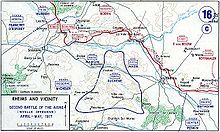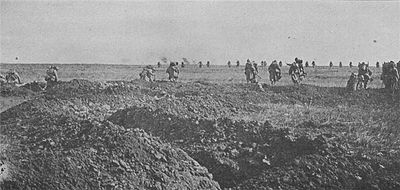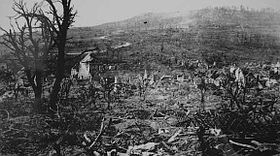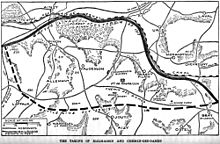Second Battle of the Aisne - Picture
More about World War 1

|
|
Second Battle of the Aisne
Date: Date
16 April - 9 May, and 24 October 1917
Location
Between Soissons and Reims, France
Result
German victory
Date: 16 April - 9 May, and 24 October 1917
Location: Between Soissons and Reims, France
Result: German victory
Belligerents:
: France
Commanders and leaders:
: Robert Nivelle
Charles Mangin
Franx§ois Anthoine
Olivier Mazel
Strength:
: 1 million, 7,000 guns
Casualties and losses:
: 118,000 casualties
This article is about the 1917 battle. For other battles of the Aisne see Battle of the Aisne.
The Second Battle of the Aisne (French: La bataille du Chemin des Dames, or French: Seconde bataille de l'Aisne), was the massive main assault of the French military's Nivelle Offensive or Chemin des Dames Offensive in 1917 during World War I.
Robert Nivelle, Commander-in-Chief of the French army, initiated the plan in December 1916 after he replaced Joseph Joffre, who had been disgraced by a series of strategic defeats. The objective of his plan was to secure a prominent, 80 km long, east-west ridge underlain by large, quarried caves that had been sheltering German troops from the French artillery. When the French frontal assault along the Chemin des Dames began in April 1917, it was countered everywhere by profoundly intense German machine gun fire and mortar attacks that stalled any attempt of an advance by the second day, resulting in horrific numbers of deaths. The main battle ended in disaster only a few weeks after it began, destroying Nivelle's career and sparking widespread mutiny throughout the French army.
The ridge at Chemin des Dames was finally captured by the French in the Battle of La Malmaison led by Marshal Philippe Pétain five months later.
Background

Picture - The front line at various stages in the battle.
When he succeeded Joffre as commander of the French army, Nivelle argued that an immense onslaught against the German lines would bring French victory in 48 hours. He believed the Germans were too bloodied from the battles at Verdun and the Somme to offer an effective, sustained defence, especially if it were preceded by a large-scale diversionary attack by the British.
The French War Minister, Hubert Lyautey, and Chief of Staff General Henri-Philippe Pétain, along with British Commander-in-Chief, Sir Douglas Haig, were all strongly opposed to this plan. In the face of this opposition, Nivelle threatened to resign if the offensive did not go ahead, and the French government found itself in a difficult situation. Nivelle had not yet lost a battle, and he also had the enthusiastic support of British Prime Minister David Lloyd George. Caught between a rock and a hard place, French Prime Minister Aristide Briand decided to support Nivelle, and the war minister resigned in protest.
The Nivelle Offensive was conceived as a vast operation, involving around 1.2 million troops and 7,000 guns on a broad front between Roye and Reims. Its primary focus was a massive assault on the German positions along the Aisne river.
The plan, which had been in development since December 1916, was plagued by delays and information leaks. By the time the offensive began in April 1917, its details were well-known to the Germans, who had ample time to take appropriate defensive measures. Additionally, the German retreat to the Hindenburg Line had undercut most of the tactical assumptions of the French plan. Despite being forced to advance across relatively unknown ground, at a defensive position carefully chosen by the enemy - about which the French had little reliable intelligence - Nivelle determined to press the attack.
Battle

Picture - French charge on the Chemin des Dames
On 16 April 1917, after a week of diversionary attacks by the British at Arras, nineteen divisions of the French 5th and 6th armies, led by Mazel and Charles Mangin, attacked the German line along an 80 km stretch from Soissons to Reims. An impressive amount of artillery firepower was concentrated on the German lines, but to no avail since the ridge was underlain by underground quarries that served as deep shelters. Forewarned, the Germans had concentrated about 100 machine guns, including the new MG08/15 light machine guns, for every 1000 metres of front; they were also well entrenched, and their positions were deep. Situated on the high ground overlooking the valley of the Aisne River, the German 7th army (under Max von Boehn) had little difficulty holding their positions. On the first day of combat alone, the French suffered over 40,000 casualties and lost 150 tanks. The creeping barrage was also poorly executed and failed to adequately cover the advance.
On the second day, the French 4th army, led by Franx§ois Anthoine, launched an attack east of Reims towards Moronvilliers (the Battle of the Hills). Fritz von Below's First Army easily repelled this assault.
Nivelle continued to order full-scale attacks until 20 April 1917. Some small gains were made by Mangin to the west of Soissons and although the assault was scaled back over the next few weeks, by 5 May 1917, the 4 km eastern stretch of the Chemin des Dames Ridge in the area of the Plateau de Californie ("California Plateau") and the town of Craonne had been captured. Incongruously, these smaller, scaled-back attacks proved more successful than the earlier, larger ones.
Aftermath

Picture - The complete destruction of village of Soupir in 1917.
Although often characterized as a dismal failure, the offensive did net gains of as much as seven kilometers. However, it had been announced and billed as a crushing blow to the Germans, and no breakthrough had been achieved. Casualty rates were incredibly high; twenty percent for the entire army by 10 May, and some divisions suffered more than sixty percent.
On 3 May the French 2nd Division refused to follow its orders to attack, and this mutiny soon spread throughout the army. Following a final, ineffective four-day assault, the Nivelle Offensive was abandoned in disarray on 9 May 1917.
While the Germans lost around 40,000, the French suffered over 118,000 casualties. The politicians and public were stunned by the chain of events in this tragedy of errors and, a week later, on 16 May Nivelle was finally sacked and moved to North Africa. He was replaced by the considerably more cautious Pétain, who made no attempts to commit his forces to large scale offensives. The French would go on the defensive for the following months, in order to avoid high casualties and to give back confidence to soldiers in their own High Command.
On 20 May 1917, General Max von Boehn who had commanded IX Reserve Corps was awarded Oakleaves (similar to a bar) to his Pour le Mérite for "outstanding leadership during the 1917 French Aisne offensive and distinction during the battle of Chemin des Dames".
French capture of La Malmaison

Picture - Capture of La Malmaison
The final action of the campaign was a French attack called the Battle of La Malmaison (French: Bataille de la Malmaison) headed by Marshal Pétain which lead to the capture the town of La Malmaison and control of the Chemin des Dames ridge on 24 October 1917. The French artillery preparation was massive and well coordinated. When troops from the 11th, 14th, and 21st Army Corps attacked, protected by an artillery barrage, the German defenders were worn down. Tanks had been used again but this time they were lighter, faster and their attack was coordinated with the infantry.
This forced the Germans to withdraw from the plateau of the Chemin des Dames and relocate to the north of the Ailette Valley.
This French victory in October did not compensate for the dramatic failure of the Battle of the Chemin des Dames in April and May, but it established a new strategy based on massive use of modern equipment (artillery, tanks) concentrated on a specific point in the front.
Louis de Cazenave (1897-2008), last survivor of the 1917 Battle of Chemin des Dames.
Media related to Battle of the Aisne (1917) at Wikimedia Commons
Footnotes
Evans, M. M. (2004). Battles of World War I. Select Editions. ISBN 1-84193-226-4.
Keegan, John.The First World War. New York: Alfred A. Knopf, 1999. ISBN 0-375-40052-4
Strachan, Hew. The First World War. New York: Viking, 2003. ISBN 1-43529-266-9
More aircraft.
Source: WikiPedia